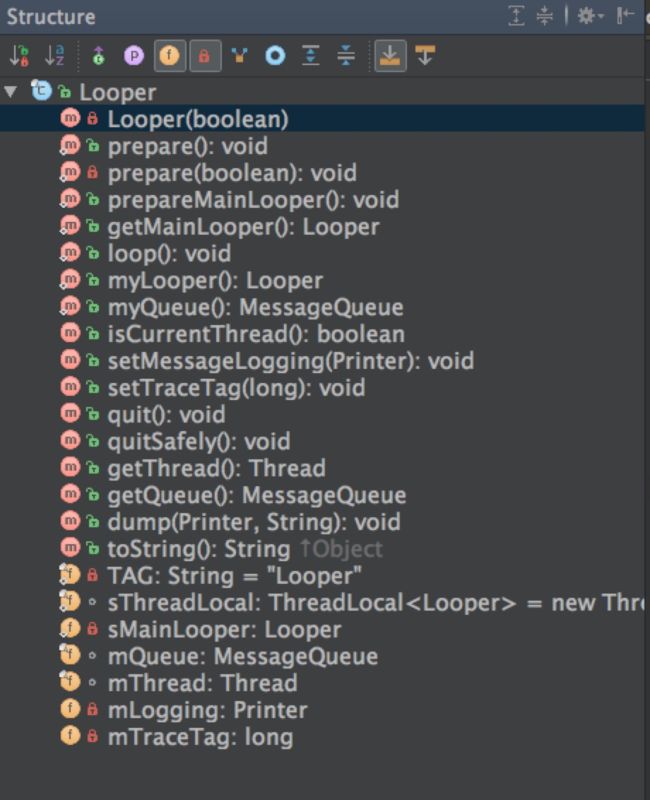移步Android Handler机制详解
1 Looper这个类的结构
2 Looper(boolean)构造函数
private Looper(boolean quitAllowed) {
// 创建MessageQueue对象
mQueue = new MessageQueue(quitAllowed);
// 记录当前线程
mThread = Thread.currentThread();
}
- 创建了一个MessageQueue,并且把当前线程赋值给本地变量的mThread。
- 1 这样就实现了Looper和MessageQueue的关联
- 2 这样就实现了Thread和Looper的关联
- Loop类就一个构造函数,构造函数也是private,只有在private static void prepare(boolean quitAllowed)调用**,而这个静态方法也是private的
- Looper这个类的对象不能直接创建,必须通过Looper来的两个静态方法prepare()/prepareMainLooper()来间接创建
3 Looper.prepare();
代码在Looper.java的82行
/** Initialize the current thread as a looper.
* This gives you a chance to create handlers that then reference
* this looper, before actually starting the loop. Be sure to call
* {@link #loop()} after calling this method, and end it by calling
* {@link #quit()}.
*/
public static void prepare() {
prepare(true);
}
- 初始化当前线程和Looper
4 prepare(boolean)方法
代码在Looper.java的86行
- 入参boolean表示Looper是否允许退出,true就表示允许退出,对于false则表示Looper不允许退出。
private static void prepare(boolean quitAllowed) {
//每个线程只允许执行一次该方法,第二次执行的线程的TLS已有数据,则会抛出异常。
if (sThreadLocal.get() != null) {
throw new RuntimeException("Only one Looper may be created per thread");
}
//创建Looper对象,并且保存到当前线程的TLS区域。
sThreadLocal.set(new Looper(quitAllowed));
}
代码在Looper.java的86行
static final ThreadLocal sThreadLocal = new ThreadLocal();
5 prepareMainLooper()方法
代码在Looper.java的99行
/**
* Initialize the current thread as a looper, marking it as an
* application's main looper. The main looper for your application
* is created by the Android environment, so you should never need
* to call this function yourself. See also: {@link #prepare()}
*/
public static void prepareMainLooper() {
// 设置不允许退出的Looper
prepare(false);
synchronized (Looper.class) {
//将当前的Looper保存为Looper。每个线程只允许执行一次
if (sMainLooper != null) {
throw new IllegalStateException("The main Looper has already been prepared.");
}
sMainLooper = myLooper();
}
}
5.1 注释
- 初始化当前当前线程的looper。并且标记为一个程序的主Looper。
- 由Android环境来创建应用程序的主Looper。因此这个方法不能由咱们来调用。
5.2 方法解析
- 首先 通过方法我们看到调用了prepare(false);注意这里的入参是false
- 其次 做了sMainLooper的非空判断,如果是有值的,直接抛异常,因为这个sMainLooper必须是空,因为主线程有且只能调用一次。prepareMainLooper(),如果sMainLooper有值,怎说说明prepareMainLooper()已经被调用了,而sMainLooper的赋值是由myLooper来执行,
5.3 sMainLooper
代码在Looper.java的 69行
private static Looper sMainLooper; // guarded by Looper.class
- Looper对象啊。但是它是静态的
- 在Java7之前,静态变量存在永久代(PermGen)。
- 在Java7之后,将变量的存储转移到了堆。
- 个sMainLooper就是主线程的Looper。所以只有通过prepareMainLooper()就可以给主线程Looper赋值了
6 myLooper()方法
代码在Looper.java的173行
/**
* Return the Looper object associated with the current thread. Returns
* null if the calling thread is not associated with a Looper.
*/
public static @Nullable Looper myLooper() {
return sThreadLocal.get();
}
- 这里的sThreadLocal.get()是和prepare(boolean)方法里面的sThreadLocal.set(new Looper(quitAllowed));一一对应的。
- 在prepareMainLooper里面调用myLooper(),那么myLooper()方法的返回有没有可能为null?
- 第一步就是调用prepare(false);,所以说myLooper()这个方法的返回值是一定有值的。
7 Looper.loop();
代码在Looper.java的 122行
/**
* Run the message queue in this thread. Be sure to call
* {@link #quit()} to end the loop.
*/
public static void loop() {
// 获取TLS存储的Looper对象
final Looper me = myLooper();
//没有Looper 对象,直接抛异常
if (me == null) {
throw new RuntimeException("No Looper; Looper.prepare() wasn't called on this thread.");
}
//获取当前Looper对应的消息队列
final MessageQueue queue = me.mQueue;
// Make sure the identity of this thread is that of the local process,
// and keep track of what that identity token actually is.
Binder.clearCallingIdentity();
// 确保权限检查基于本地进程,而不是基于最初调用进程
final long ident = Binder.clearCallingIdentity();
// 进入 loop的主循环方法
// 一个死循环,不停的处理消息队列中的消息,消息的获取是通过MessageQueue的next()方法实现
for (;;) {
// 可能会阻塞
Message msg = queue.next(); // might block
// 如果没有消息,则退出循环
if (msg == null) {
// No message indicates that the message queue is quitting.
return;
}
// This must be in a local variable, in case a UI event sets the logger
// 默认为null,可通过setMessageLogging()方法来指定输出,用于debug功能
Printer logging = me.mLogging;
if (logging != null) {
logging.println(">>>>> Dispatching to " + msg.target + " " +
msg.callback + ": " + msg.what);
}
// 用于分发消息,调用Message的target变量(也就是Handler了)的dispatchMessage方法来处理消息
msg.target.dispatchMessage(msg);
if (logging != null) {
logging.println("<<<<< Finished to " + msg.target + " " + msg.callback);
}
// Make sure that during the course of dispatching the
// identity of the thread wasn't corrupted.
// 确保分发过程中identity不会损坏
final long newIdent = Binder.clearCallingIdentity();
if (ident != newIdent) {
// 打印identiy改变的log,在分发消息过程中是不希望身份被改变
Log.wtf(TAG, "Thread identity changed from 0x"
+ Long.toHexString(ident) + " to 0x"
+ Long.toHexString(newIdent) + " while dispatching to "
+ msg.target.getClass().getName() + " "
+ msg.callback + " what=" + msg.what);
}
// 将Message放入消息池
msg.recycleUnchecked();
}
}
- loop进入循环模式,不断重复下面的操作,直到没有消息时退出循环
- 读取MessageQueue的下一条Message
- 把Message分发给相应的target
- 再把分发后的Message回到消息池,以便重复利用
8 Looper的退出循环方法
Looper里面退出循环有两个方法分别是quit()和quitSafely()方法
8.1 Looper.quit()方法
代码在Looper.java的 227行
/**
* Quits the looper.
*
* Causes the {@link #loop} method to terminate without processing any
* more messages in the message queue.
*
* Any attempt to post messages to the queue after the looper is asked to quit will fail.
* For example, the {@link Handler#sendMessage(Message)} method will return false.
*
* Using this method may be unsafe because some messages may not be delivered
* before the looper terminates. Consider using {@link #quitSafely} instead to ensure
* that all pending work is completed in an orderly manner.
*
*
* @see #quitSafely
*/
public void quit() {
mQueue.quit(false);
}
- 退出循环
- 将终止(loop()方法)而不处理消息队列中的任何更多消息。在调用quit()后,任何尝试去发送消息都是失败的。
- 例如Handler.sendMessage(Message)方法将返回false。因为循环终止之后一些message可能会被无法传递,所以这个方法是不安全的。
8.2 Looper.quitSafely()方法
代码在Looper.java的 227行
/**
* Quits the looper safely.
*
* Causes the {@link #loop} method to terminate as soon as all remaining messages
* in the message queue that are already due to be delivered have been handled.
* However pending delayed messages with due times in the future will not be
* delivered before the loop terminates.
*
* Any attempt to post messages to the queue after the looper is asked to quit will fail.
* For example, the {@link Handler#sendMessage(Message)} method will return false.
*
*/
public void quitSafely() {
mQueue.quit(true);
}
- 安全退出循环
- 调用quitSafely()方法会使循环结束,只要消息队列中已经被传递的所有消息都将被处理。然而,在循环结束之前,将来不会提交处理延迟消息。
- 调用退出后,所有尝试去发送消息都将失败。就像调用Handler.sendMessage(Message)将返回false。
9 主线程的Looper的初始化
那么主线程的Looper是什么时候初始化的那?是在系统启动的时候,初始化的。
代码在ActivityThread.java 5401行
public static void main(String[] args) {
Trace.traceBegin(Trace.TRACE_TAG_ACTIVITY_MANAGER, "ActivityThreadMain");
SamplingProfilerIntegration.start();
// CloseGuard defaults to true and can be quite spammy. We
// disable it here, but selectively enable it later (via
// StrictMode) on debug builds, but using DropBox, not logs.
CloseGuard.setEnabled(false);
Environment.initForCurrentUser();
// Set the reporter for event logging in libcore
EventLogger.setReporter(new EventLoggingReporter());
AndroidKeyStoreProvider.install();
// Make sure TrustedCertificateStore looks in the right place for CA certificates
final File configDir = Environment.getUserConfigDirectory(UserHandle.myUserId());
TrustedCertificateStore.setDefaultUserDirectory(configDir);
Process.setArgV0("");
/*** 重点 */
Looper.prepareMainLooper();
ActivityThread thread = new ActivityThread();
thread.attach(false);
if (sMainThreadHandler == null) {
sMainThreadHandler = thread.getHandler();
}
if (false) {
Looper.myLooper().setMessageLogging(new
LogPrinter(Log.DEBUG, "ActivityThread"));
}
// End of event ActivityThreadMain.
Trace.traceEnd(Trace.TRACE_TAG_ACTIVITY_MANAGER);
/*** 重点 */
Looper.loop();
throw new RuntimeException("Main thread loop unexpectedly exited");
}
ActivityThread不是一个thread,ActivityThread是一个类
- 首先调用了Looper的静态方法prepareMainLooper()给主线程绑定一个Looper,同时设置Looper对应的MessageQueue对象的mQuitAllowed为false,则该messageQueue是不能退出的。
- 其次调用Looper.loop();开启循环
参考
Android Handler机制4之Looper与Handler简介
